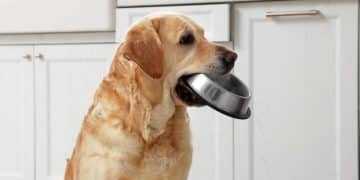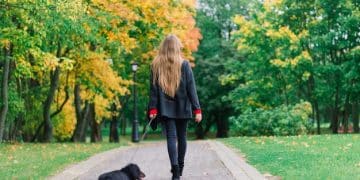Resource Guarding in Dogs: Safely Managing It in 2025
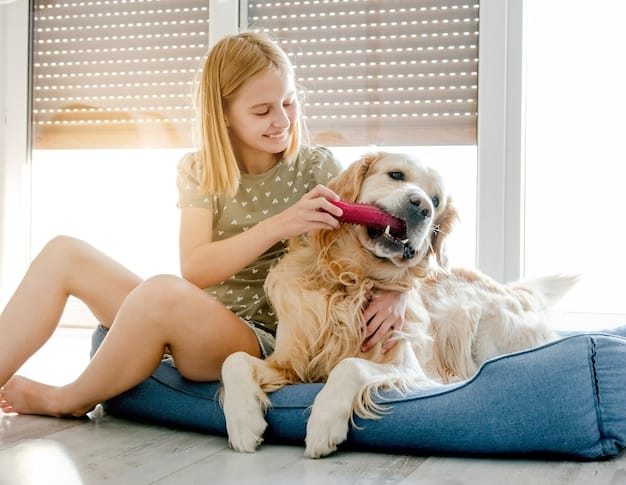
Resource guarding in dogs involves behaviors like growling or snapping when they perceive someone (human or animal) approaching their valued items; in 2025, safe management and modification strategies emphasize positive reinforcement and creating a secure environment for the dog.
Is your dog showing signs of resource guarding? Understanding this behavior is crucial for a harmonious home in 2025.
Understanding Resource Guarding in Dogs
Resource guarding is a common behavior in dogs where they exhibit possessive actions to protect items they perceive as valuable. It’s essential to understand that resource guarding isn’t necessarily aggression but rather a display of anxiety and insecurity related to losing something they value.
Recognizing the signs early and understanding the underlying motivations can assist owners in properly managing and modifying this behavior. By doing so, we can ensure a safer and more enjoyable relationship with our dogs.
What Possessions Do Dogs Guard?
Dogs are known to guard a variety of items, not just food. Understanding what your dog is protective over can assist with management.
- Food: This include their bowl, treats, or even scraps found on the floor.
- Toys: High-value toys such as favored bones, stuffed animals, or balls are prime candidates.
- Places: Their bed, a specific spot on the couch, or even a certain area in the yard.
- People: Affectionate behavior displayed towards a specific person in the household can also be guarded.
Identifying the specific triggers helps in tailoring a strategy to address resource guarding effectively.
In conclusion, understanding what resource guarding encompasses helps to contextualize the behavior and take the first step towards a solution.
Identifying the Signs of Resource Guarding
Identifying the subtle signs of resource guarding early on is paramount to preventing escalation and ensuring the safety of everyone involved. These signs can range from subtle body language cues to more overt displays of aggression.
Being vigilant and attentive to your dog’s behavior can help you implement proactive measures. Early identification is key to effectively modifying the behavior.
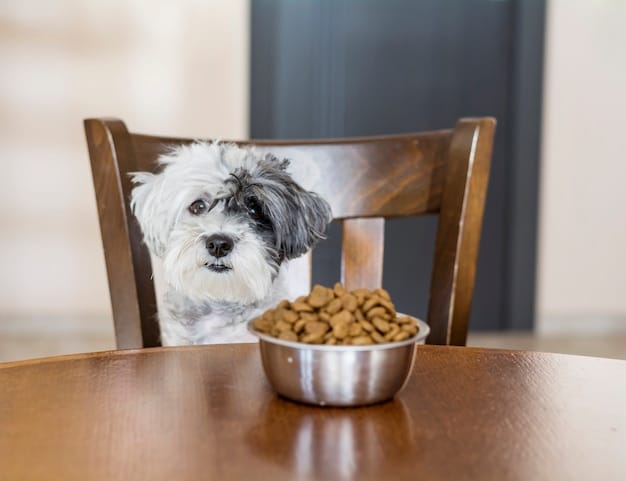
Subtle Signs of Resource Guarding
Recognizing the early indicators allows for timely intervention and prevention of more challenging behaviors.
- Freezing: The dog becomes still and tense when someone approaches their item.
- Hard Stare: Direct, unwavering eye contact directed at the approaching person or animal.
- Lip Curling: Showing teeth or curling the lip as a warning sign.
- Body Posturing: Leaning over the item, hunching, or otherwise positioning their body to block access.
By recognizing these signs, owners can take preventive measures before the behavior escalates.
In essence, becoming skilled at reading your dog’s body language is instrumental in detecting and managing resource guarding.
Safe Management Strategies
When dealing with resource guarding, a safe management strategy is crucial. These steps help prevent incidents and ensure the well-being of everyone around the dog. It’s essential to create a safe environment where the dog doesn’t feel the need to protect their resources.
Management focuses on minimizing opportunities for the dog to exhibit resource guarding behaviors. Reducing stress and anxiety can foster positive interactions around valued items.
Consider these strategies for establishing a secure framework that lessens the likelihood of resource guarding incidents.
Creating a Safe Zone
Designating safe feeding areas and quiet spaces can greatly reduce your dog’s anxiety and possessive behaviors.
- Feed in a Quiet Location: Provide meals in a place with minimal foot traffic or disturbances.
- Avoid Approaching While Eating: Give your dog space while eating, without any approaching or hovering.
- Safe Resting Spots: Allow unrestricted access to their bed or resting area, without disturbance.
By creating a safe environment, you alleviate the dog’s need to guard resources, promoting a sense of security.
Overall, the establishment of safe zones is a significant aspect of managing resource guarding effectively.
Modifying Resource Guarding: Positive Reinforcement Techniques
Modifying resource guarding requires patience, consistency, and positive reinforcement techniques. The goal is to change the dog’s emotional response to someone nearing their valued items, associating it with pleasant experiences rather than anxiety.
Positive reinforcement involves rewarding desired behaviors to make them more likely to occur in the future. Using treats, praise, and gentle encouragement can foster a positive connection with your dog.
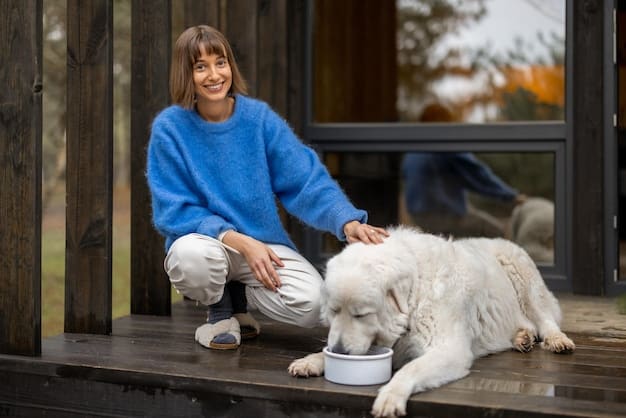
- Approach and Treat: Whenever you approach the dog’s food bowl or guarded item, toss a high-value treat towards them. This helps them associate your approach with positivity.
- Trade-Up: Offer something of higher value than what the dog is guarding. For example, if they have a toy, offer a tastier treat in exchange.
- Hand-Feeding: Feed meals by hand, creating a positive association with your presence during feeding times.
Consistency is key. Regular practice and consistent reinforcement strengthen the positive association between approach and reward.
In conclusion, positive reinforcement techniques can significantly reduce resource guarding behavior by changing the dog’s perception of being approached.
When to Seek Professional Help
While many cases of resource guarding can be managed and modified with home strategies, some situations require the guidance of a professional. Knowing when to seek expert help is crucial for the safety of everyone involved.
If resource guarding escalates to aggressive behavior or poses a risk to family members, consulting a qualified professional is essential. An expert can assess the situation and develop a tailored modification plan.
Consider the following guidelines for determining when professional intervention is necessary.
Signs That Professional Help Is Needed
Identifying the circumstances when expert assistance is vital ensures the well-being of the dog and the safety of those around them.
- Aggressive Behavior: If the dog is biting, snapping, or showing aggressive signs, seek professional guidance immediately.
- Escalation: If the resource guarding behavior is worsening despite your efforts.
- Anxiety: If the dog exhibits significant stress, anxiety, or fear related to resource guarding, professional help can address these underlying emotional issues.
A board-certified veterinary behaviorist or certified professional dog trainer is best suited to assess the situation and provide effective solutions.
Ultimately, knowing when to seek professional help is a responsible approach to managing resource guarding and ensuring a safe and harmonious environment.
Preventing Resource Guarding in Puppies
Preventing resource guarding from developing in puppies is often easier than modifying it in adult dogs. Early training and socialization can help puppies develop a positive attitude toward sharing and human interaction around their resources.
Socialization involves exposing puppies to various stimuli, people, and environments to build confidence and adaptability. Training involves teaching them commands and associating positive experiences with sharing.
Consider the following strategies for fostering positive behavior in puppies.
- Early Socialization: Expose puppies to different people, animals, and environments.
- Gentle Handling: Get them accustomed to being touched while they are eating or playing.
- Positive Reinforcement: Teach them to associate your approach with pleasant experiences.
Consistency and patience are vital in shaping a puppy’s behavior and attitude toward sharing resources.
In summary, early socialization and training are crucial for preventing resource guarding in puppies by building a positive foundation of trust and security.
| Key Point | Brief Description |
|---|---|
| 🛡️ Understanding Resource Guarding | Recognize it’s about anxiety, not aggression, linked to valued items. |
| ⚠️ Identifying Signs | Watch for freezing, hard stares, lip curling as early signals. |
| 🐾 Management Strategies | Create safe zones for feeding, avoiding approach while eating. |
| ❤️ Positive Reinforcement | Use treats, trade-ups, and hand-feeding to change associations. |
FAQ
▼
Resource guarding is when a dog shows possessive behavior over items they value, like food or toys. They may growl or snap if someone approaches them or their items.
▼
Early signs include freezing, a hard stare, lip curling, and body posturing around the item the dog is guarding. Recognizing these helps prevent escalation.
▼
Manage it by feeding in a quiet location, avoiding approaching the dog while eating, and providing safe resting spots where they won’t be disturbed.
▼
Use treats when approaching the dog’s items. Offer something of higher value (trade-up), or hand-feed meals. This associates your presence with positivity.
▼
Seek professional help if the dog exhibits aggressive behavior, if the behavior is worsening, or if the dog shows significant stress or anxiety.
Conclusion
In conclusion, understanding, managing, and modifying resource guarding in dogs involves a combination of awareness, safe strategies, and positive reinforcement. By implementing these methods, owners can foster a trusting relationship with their dogs while ensuring a safe and harmonious environment for everyone involved.
